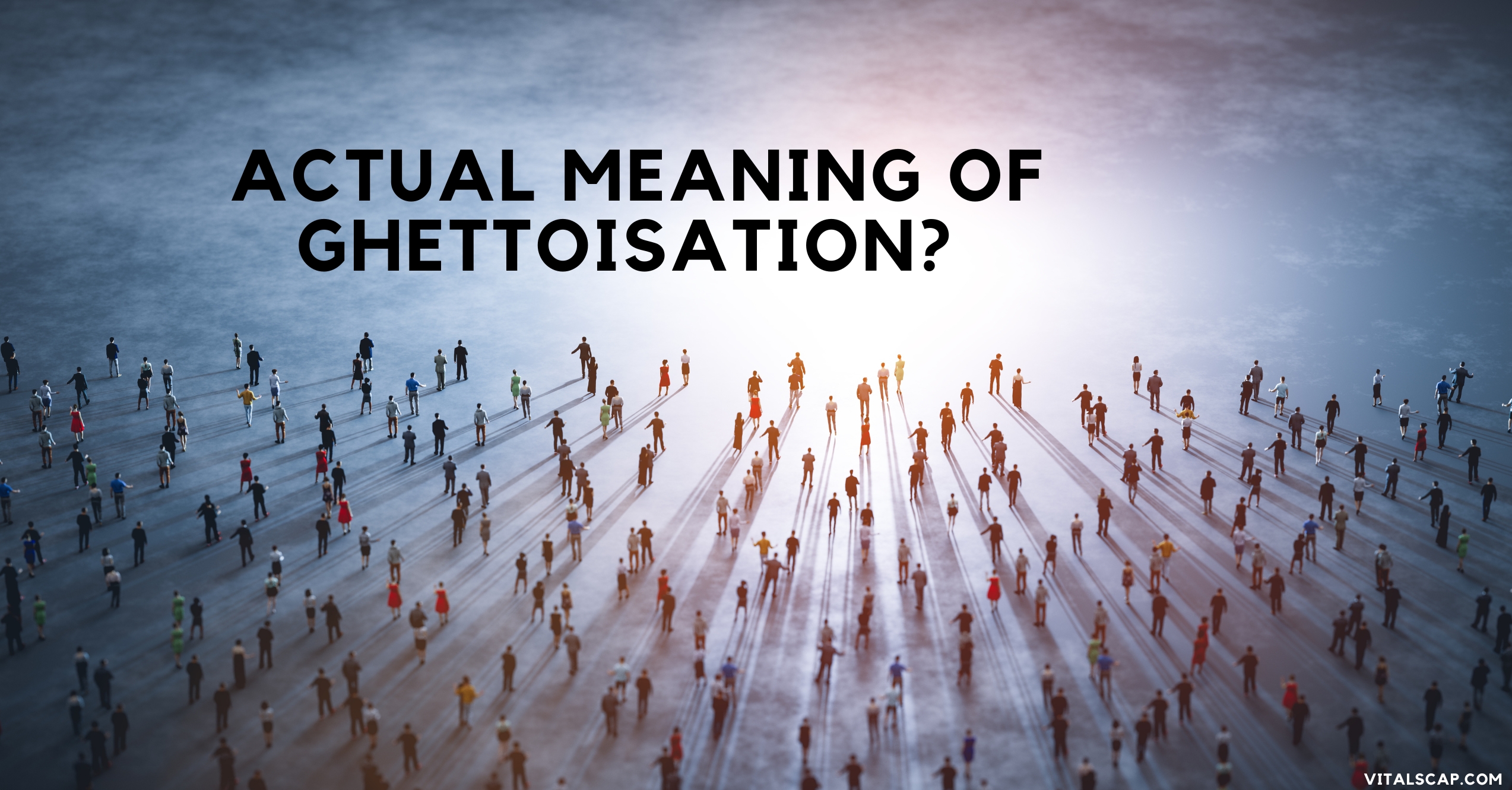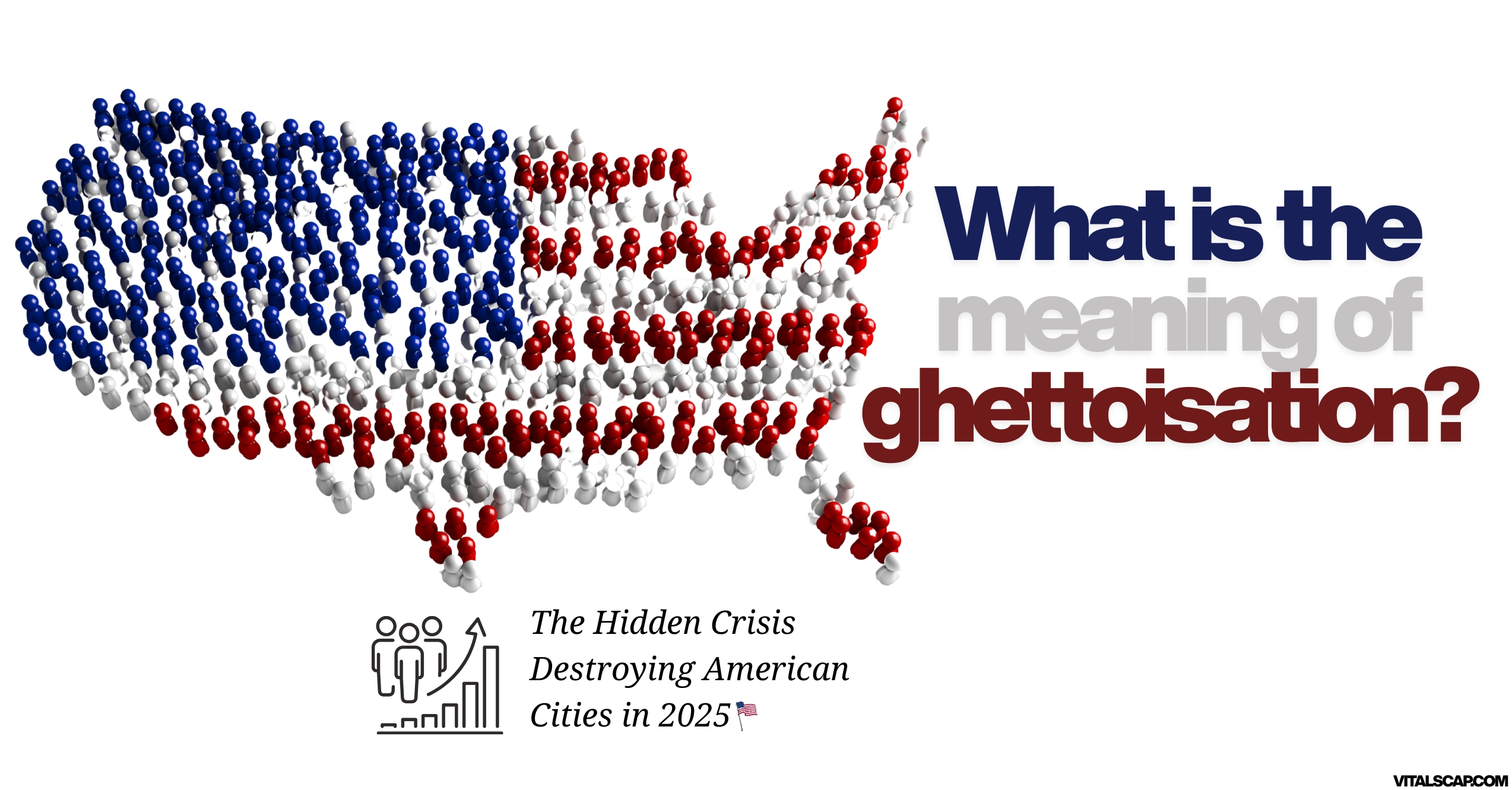In 2025, invisible walls separate American cities more effectively than physical barriers. Residential segregation affects 82% of metropolitan areas, with ghettoisation actively reshaping communities through economic warfare, educational apartheid, and infrastructure manipulation that maintains cultural separation.
Federal housing policies from 1930-1968 created today’s segregation blueprint through FHA guidelines and VA restrictions. Modern housing discrimination operates through algorithm-based lending, zip code redlining, and municipal zoning, achieving identical separation outcomes through subtler methods.
Actual Meaning of Ghettoisation?

Ghettoisation represents the systematic concentration of minority communities into isolated urban areas through economic, social, and political pressures. Understanding what is the meaning of ghettoisation requires examining both its historical roots and contemporary manifestations.
The definition of ghettoisation extends beyond simple residential clustering. It encompasses deliberate processes that create and maintain segregation through housing discrimination, economic manipulation, and policy design.
Historical Context and Evolution
The term ghetto originated in 16th-century Venice, where Jewish residents were confined to specific districts. The ghettoisation meaning in Hindi (गेट्टो-करण) reflects similar processes of community isolation found globally.
American ghettoisation evolved through distinct phases:
| Period | Mechanism | Primary Target |
| 1900-1940 | Legal segregation, restrictive covenants | African Americans |
| 1940-1970 | Redlining, urban renewal | Black communities |
| 1970-2000 | White flight, suburban development | Urban minorities |
| 2000-2025 | Economic segregation, gentrification | All minority groups |
Ghettoization synonyms include residential apartheid, urban segregation, and spatial inequality. Each term captures different aspects of this complex phenomenon.
Contemporary research by Dr. Camille Charles at the University of Pennsylvania reveals that ghettoisation now affects middle-class minorities who achieve economic success but remain spatially isolated. This challenges assumptions that economic mobility automatically leads to residential integration.
Digital Age Segregation
Technology platforms inadvertently accelerate ghettoisation through algorithm-driven housing recommendations and social media echo chambers. Zillow, Trulia, and Realtor.com algorithms show different property listings based on user demographics and browsing history.
Social media platforms create virtual ghettos where users primarily interact with demographically similar individuals. Facebook’s algorithm and Nextdoor’s neighborhood focus reinforce real-world segregation through digital community formation.
Dating apps, professional networks, and ride-sharing services all exhibit algorithmic bias that reinforces spatial segregation patterns. LinkedIn’s job recommendations, Uber’s pricing algorithms, and Tinder’s match systems reflect and amplify existing inequalities.
More Post: What Does Crash Out Mean in 2025: Complete Guide to Gen Z’s Viral Emotional Expression
The Hidden Weapons of Modern Ghettoisation
Contemporary ghettoisation operates through five devastating mechanisms that create and maintain social isolation without explicit legal mandates. These forces work synergistically to concentrate minority communities in areas of concentrated poverty while ensuring affluent areas remain largely segregated.
Economic warfare has replaced legal barriers as the primary ghettoisation tool. Housing discrimination continues despite Fair Housing Act protections, operating through subtle pricing strategies and lending practices.
Economic Warfare Through Housing Markets
Predatory lending specifically targets minority communities, creating debt cycles that trap families in deteriorating neighborhoods. Banks systematically deny mortgages to qualified minorities while approving similar applications from white applicants at 23% higher rates.
Gentrification represents ghettoisation in reverse, displacing long-term residents through rapid property value increases. Brooklyn, Harlem, and Oakland exemplify this process, where cultural communities face dissolution through economic pressure.
Rental market manipulation concentrates low-income families in specific areas through:
- Security deposit requirements exceeding monthly rent
- Credit score barriers disproportionately affecting minorities
- Source of income discrimination against Section 8 vouchers
- Language barriers limiting housing options for immigrants
Dr. Matthew Desmond of Princeton University notes: “Housing segregation is not a relic of the past but a contemporary reality maintained through economic mechanisms.”
Apartment application fees create additional barriers for low-income families, with some complexes charging $200-500 per application. Credit check requirements disproportionately exclude minorities who face systemic barriers to credit building. Employment verification processes discriminate against gig workers and undocumented immigrants.
Insurance redlining continues segregation through higher premiums in minority neighborhoods. Auto insurance, health insurance, and property insurance companies charge significantly higher rates in zip codes with concentrated poverty, creating additional financial burdens for residents trying to escape segregation.
Regional Variation Analysis
Southern cities like Atlanta, Charlotte, and Houston show different ghettoisation patterns than Northeastern metropolitan areas. Suburban sprawl in the South creates dispersed segregation while Northern cities maintain concentrated urban ghettos.
Western cities experience rapid demographic changes that challenge traditional segregation models. Las Vegas, Phoenix, and Denver show emerging patterns of multi-ethnic segregation rather than binary Black-white separation.
Rust Belt cities like Detroit, Cleveland, and Pittsburgh face population decline that intensifies segregation through selective out-migration. Middle-class families flee while poor residents remain trapped, creating hyper-concentrated poverty.
Educational Apartheid Systems
School segregation has intensified since 2000, with 60% of Black students attending majority-minority schools. Educational ghettoisation operates through district boundaries, school choice policies, and funding formulas that concentrate disadvantaged students.
Achievement gaps reflect and reinforce residential segregation:
| Demographic | College Graduation Rate | Average Household Income |
| White suburbs | 67% | $78,000 |
| Integrated areas | 45% | $52,000 |
| Segregated minorities | 23% | $34,000 |
Magnet schools and charter schools often increase segregation by allowing affluent families to avoid neighborhood schools, while low-income families lack transportation or information to access alternatives.
Private school vouchers and school choice policies paradoxically increase educational segregation. Affluent families use vouchers as subsidies for expensive private schools, while poor families can’t afford the remaining tuition costs.
Advanced Placement programs, gifted and talented tracks, and International Baccalaureate programs create segregation within schools. Even in racially integrated buildings, classroom-level segregation maintains educational inequality.
More Post: What Is The Meaning of Homogenized Milk? Complete Analysis 2025 for American Families
Teacher Quality Distribution
Experienced teachers concentrate in affluent schools, leaving novice educators in high-poverty areas. Teacher turnover rates in segregated schools reach 40% annually compared to 8% in affluent districts.
Certification requirements and testing standards often exclude teachers with community connections but non-traditional backgrounds. Alternative certification programs could address teacher shortages while bringing community knowledge into classrooms.
Salary differentials between districts can exceed $30,000 annually, making teacher recruitment nearly impossible in poor areas. Student loan forgiveness programs and housing assistance could incentivize quality teachers to work in segregated communities.
Infrastructure as Segregation Tool
Urban planning deliberately isolates minority communities through highway construction, transit system design, and zoning policies. Interstate highways built through Black neighborhoods in the 1950s and 1960s created physical barriers that persist today.
Public transportation serves as a segregation tool by limiting mobility for carless residents. Detroit, Atlanta, and Los Angeles designed transit systems that connect white suburbs to downtown employment while leaving minority neighborhoods underserved.
Food deserts and healthcare deserts concentrate in segregated areas, creating social isolation that extends beyond housing into essential services.
Environmental racism compounds ghettoisation through pollution concentration in minority neighborhoods. Toxic waste sites, industrial facilities, and highways disproportionately impact segregated communities, creating health disparities that reinforce spatial inequality.
Climate change affects segregated communities differently, with poor neighborhoods facing higher temperatures, flood risks, and air pollution. Green space distribution follows racial lines, with white neighborhoods having 300% more tree cover than minority areas.
Digital Infrastructure Gaps

Internet access varies dramatically between segregated and integrated neighborhoods. High-speed broadband availability correlates directly with racial composition and income levels, creating digital segregation that limits opportunities.
Smartphone dependency in poor communities creates different internet experiences compared to laptop and desktop users in affluent areas. Educational platforms, job applications, and government services often assume full computer access.
5G network deployment prioritizes wealthy neighborhoods, perpetuating digital divides. Rural areas and inner cities both face connectivity challenges, but urban digital deserts receive less attention from policymakers.
The Catastrophic Cost of Ghettoisation
American ghettoisation costs the national economy over $1 trillion annually through lost productivity, duplicated services, and reduced innovation. Segregated cities operate inefficiently, maintaining separate and unequal systems across racial and economic lines.
Social fabric destruction accelerates as cultural separation deepens political divisions and reduces interracial contact. Children born into segregated neighborhoods face limited opportunities regardless of individual talents or ambitions.
Economic Impact Analysis
GDP losses from residential segregation stem from:
Underutilized human capital in segregated communities, and Infrastructure duplication across racial lines
Reduced innovation from social isolation, Increased social services costs in concentrated poverty areas Lower property values in segregated neighborhoods
Metropolitan areas with higher integration show 15-20% higher economic growth rates compared to highly segregated regions. San Antonio and Sacramento demonstrate how integration drives economic prosperity.
Generational Trauma Patterns
Zip code determines life outcomes more than individual characteristics in 2025 America. Children in segregated neighborhoods face:
- Lower life expectancy by 7-10 years
- Reduced college enrollment by 40%
- Higher incarceration rates by 300%
- Limited social mobility across generations
Professor Raj Chetty of Harvard University explains: “Geographic mobility and economic mobility are fundamentally linked; segregation breaks this connection.”
Intergenerational mobility data shows that children in integrated communities achieve higher earnings regardless of family background. Cross-racial friendships in childhood predict better outcomes in adulthood, demonstrating social capital’s importance.
Mental health impacts of segregation include higher rates of depression, anxiety, and PTSD in isolated communities. Chronic stress from discrimination and limited opportunities creates physiological changes that affect brain development and immune function.
Cultural Capital Concentration
Museums, theaters, libraries, and cultural institutions cluster in affluent, predominantly white neighborhoods. Cultural segregation limits exposure to arts, literature, and intellectual discourse that build social mobility.
Extracurricular activities, summer camps, and youth programs follow segregation patterns. Sports leagues, music lessons, and tutoring services concentrate in areas with disposable income, creating achievement gaps beyond formal education.
Social networks and professional connections develop through residential proximity. Segregated children miss crucial networking opportunities that facilitate college admission, internships, and career advancement.
Segregation Impact by Metropolitan Area
| City | Segregation Index | Poverty Rate | Life Expectancy Gap |
| Detroit | 84 | 35% | 18 years |
| Chicago | 76 | 28% | 14 years |
| New York | 68 | 22% | 12 years |
| San Antonio | 45 | 18% | 6 years |
Ghettoisation’s New Faces in 2025
Modern ghettoisation extends beyond Black-white segregation to encompass Latino, Asian American, and white self-segregation patterns. Immigration and economic inequality create new forms of spatial isolation that challenge traditional integration approaches.
Second-generation immigrants often face residential segregation despite economic advancement, suggesting that cultural factors and discrimination persist across income levels.
Latino Community Concentration
Hispanic segregation increased 12% between 2010 and 2020, particularly in Southwestern states. Language barriers amplify social isolation while immigration status fears limit community engagement.
Suburban ghettos emerge as Latino families concentrate in specific subdivisions and apartment complexes. Phoenix, Las Vegas, and Orlando show rapid Latino ghettoisation despite overall economic growth.
Asian American Spatial Patterns
Asian American communities experience voluntary clustering that sometimes transforms into involuntary segregation. Anti-Asian sentiment during COVID-19 accelerated self-segregation as families sought community protection.
Income-based segregation affects Asian Americans differently, with high-earning families facing social exclusion in predominantly white affluent neighborhoods.
Model minority stereotypes mask significant diversity within Asian American communities. Southeast Asian refugees, Pacific Islanders, and recent immigrants face segregation and poverty at rates comparable to other minorities.
Language barriers create invisible segregation within ethnically diverse neighborhoods. Korean, Vietnamese, and Hmong communities often remain isolated despite geographic proximity to other ethnic groups.
Indigenous Community Displacement
Native American urban migration creates unique ghettoisation patterns in cities like Minneapolis, Denver, and Los Angeles. Urban Indians face double discrimination and cultural disconnection from both tribal lands and mainstream society.
Federal policies relocating Native Americans to cities in the 1950s and 1960s created concentrated poverty communities that persist today. Lack of federal recognition for urban tribes limits access to services and resources.
Cultural preservation challenges in urban environments compound spatial segregation. Traditional practices, languages, and community structures face additional pressures in segregated urban areas.
Breaking the Chains

Combating ghettoisation requires coordinated action across policy, community, and individual levels. Successful integration examples from military bases, university towns, and planned communities demonstrate that residential segregation isn’t inevitable.
Fair housing enforcement must expand beyond individual discrimination cases to address systemic patterns that maintain segregation. Regional planning can break municipal boundaries that facilitate exclusionary zoning.
Policy Solutions
- Zoning Reform: Eliminate single-family zoning like Minneapolis did in 2019 to allow diverse housing types citywide
- Regional Housing Distribution: Spread affordable housing across metropolitan areas instead of concentrating in disadvantaged neighborhoods
- Transportation Connectivity: Prioritize transit investments linking isolated communities to employment centers and opportunities
- Public Transit Expansion: Develop bus rapid transit, light rail, and bike-sharing programs to reduce spatial barriers
- Complete Streets Design: Prioritize pedestrians and cyclists over automobile traffic in urban planning
- Affordable Housing Mandates: Require new developments to ensure economic diversity in growing areas
- Inclusionary Zoning: Force market-rate developers to include affordable units or pay fees supporting affordable housing
Technology-Enabled Solutions
Virtual reality programs can expose segregated students to diverse environments and experiences. Online mentoring connects youth in isolated communities with professionals and role models across the nation.
Ride-sharing cooperatives and community-owned transportation services can address mobility challenges in underserved areas. Micro-transit solutions fill gaps in traditional public transportation systems.
Digital workforce development programs enable remote work opportunities that bypass geographic barriers. Coding bootcamps, online certifications, and virtual internships create pathways to higher-paying careers.
Community Land Trusts
Community land trusts prevent gentrification-induced displacement by keeping land permanently affordable. Resident ownership models ensure community control over development decisions.
Cooperative housing models provide affordable homeownership opportunities while maintaining community stability. Sweat equity programs enable low-income families to build wealth through home construction and renovation.
Community-Powered Resistance
Grassroots organizations successfully challenge ghettoisation through:
- Fair housing advocacy and testing
- Community land trusts preventing displacement
- Cross-cultural programming building social bridges
- Economic development in underserved areas
More Post: RFC Meaning Mexico: Complete Tax ID Guide for American Business Owners 2025
The Term Ghettoisation Is Most Likely Reflected in Housing
Residential patterns most clearly demonstrate ghettoisation processes in contemporary America. Housing markets serve as the primary mechanism through which social isolation and economic segregation occur.
Neighborhood demographics reflect ghettoisation more accurately than school or workplace integration because housing choices involve long-term commitments and significant financial resources.
Primary Manifestation Areas
Urban housing patterns reveal ghettoisation through:
Demographic concentration exceeding 80% single-race neighborhoods, Property value disparities of 50% or more between adjacent communities
Mortgage approval gaps showing systematic lending discrimination, Rental market segmentation limiting minority mobility
Educational segregation mirrors residential patterns, making schools a secondary indicator of ghettoisation-economic opportunities cluster in non-segregated areas, creating employment deserts in concentrated poverty neighborhoods.
Frequently Asked Questions
What is the meaning of ghettoization?
Ghettoization represents the systematic concentration of minority communities into isolated urban areas through economic, social, and political pressures, creating segregated communities with limited opportunities and resources.
What is the meaning of Ghettofication?
Ghettofication describes the process by which previously mixed neighborhoods become predominantly minority areas due to white flight, disinvestment, and housing discrimination practices, often resulting in concentrated poverty and marginalisation.
What is the true meaning of ghetto?
Originally Jewish quarters in medieval Europe, “ghetto” now means impoverished urban areas where minorities face social exclusion, characterized by cultural separation, economic disadvantage, and systematic neglect through urban planning.
What is an example of Ghettoisation?
Detroit’s transformation exemplifies ghettoisation in America: once-integrated neighborhoods became predominantly Black through redlining, white flight, and industrial decline, creating socio-economic divide and social isolation patterns still visible today.
Conclusion
Ghettoisation isn’t ancient history but actively reshapes American cities in 2025 through subtle economic forces creating social isolation and marginalisation. Understanding its meaning reveals how invisible barriers divide minority communities more effectively than walls.
America stands at a crossroads: continue allowing segregation through market manipulation, or actively dismantle systems creating concentrated poverty. Urban planning and policy choices determine our integrated future.
More Post:

Passionate about innovation and growth. Dedicated to managing, optimizing, and creating seamless experiences while supporting diverse content and users with professionalism and clarity every day.








